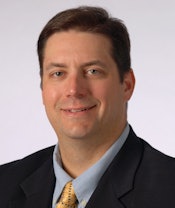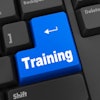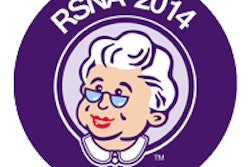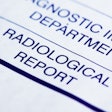
A single additional interruption in the form of a telephone call within an hour of when an on-call resident creates a preliminary report boosts the chances of a significant error in the report by 12%, according to a new study published online in Academic Radiology.
Radiology residents are often the only clinician responsible for after-hours radiology coverage, and they're required to juggle medical functions, such as interpreting exams and interacting with consulting physicians and technologists, along with nonmedical functions, such as answering telephone calls and returning pages, according to researchers from Indiana University Health Methodist Hospital.
This multitasking could negatively affect diagnostic accuracy, corresponding author Dr. Scott Steenburg told AuntMinnie.com.
 Dr. Scott Steenburg from Indiana University.
Dr. Scott Steenburg from Indiana University."We assumed that the multitasking required by being on call has the potential to negatively affect how residents perform," Steenburg said. "We wanted to see if we could identify and track telephone calls, which are one of the most frequent interruptions."
Lead author Brad Balint, Steenburg, and colleagues examined telephone log data from April 2012 through April 2013 from nine individual telephone extensions in the pediatric radiology reading room. The team noted incoming and outgoing call start and end times, as well as call duration.
During the study time frame, coverage consisted of a single on-call resident on duty from 6 p.m. to 8 a.m.; faculty radiologists were available for consultation during this period, and all residents were in their third or fourth year of training (Acad Radiol, September 30, 2014).
On-call residents created preliminary reports using a voice recognition system, Balint and colleagues wrote. In the morning, major discrepancies -- defined as any modifications in the initial interpretation that had to be communicated to the ordering physician -- were entered into a log. Minor discrepancies -- those that did not alter patient management and were not communicated to the ordering physician -- were not included in the log.
From these data, the researchers identified 39 major discrepancies during 33 shifts. These inconsistencies were found in 28 x-ray exams, eight CT scans, and three ultrasound exams. The most frequent discrepancies were extremity fractures, chest infection, and pneumothorax; most of the inconsistencies (53.8%) arose during the first half of the call shift, between 7 p.m. and 12 a.m.
During the on-call time tracked by the researchers, there were 44 phone calls per shift, on average -- or about three calls per hour. The average call length was slightly less than two minutes.
Balint and colleagues looked at the total number of calls for shifts that had produced report discrepancies. They found that these shifts had an average of 48 calls per shift, compared with 44 calls in those shifts with no inconsistencies, although the difference was not statistically significant.
The team did discover a statistically significant increase in the average number of calls in the hour preceding report discrepancies, when compared with shifts without discrepancies; in fact, a single additional phone call above the average baseline increased the odds of a major discrepancy by 12%.
"Overall, there was no significant difference in the number of calls per shift, but we did notice that in the hour preceding discrepant reports, there was an uptick in calls," Steenburg said. "We think these interruptions can distract enough to cause medical errors."
One limitation was that the study only focused on one type of interruption -- telephone calls. The researchers did not account for other types that could have affected residents' focus, such as face-to-face consults or responding to text messages or emails.
Reducing interruptions
What can be done to minimize phone call interruptions? Balint and colleagues offered three suggestions:
- Use reading room assistants to handle nonmedical tasks such as answering the telephone.
- Identify a "consultation" radiologist or resident to handle radiologist-specific medical tasks.
- Create an "interruption-free zone."
"At our institution, we have administrative staff in reading rooms who run interference," Steenburg said. "They answer the calls first and prioritize them. It turns out that many of the calls are regarding nonphysician tasks anyway."
Does running interference prevent referring doctors from communicating with radiologists, though? It's tricky, Steenburg said. The need for time-sensitive consults must be balanced with the potentially negative effect of interruptions.
"Radiologists need to be protected from interruptions that may translate to diagnostic errors, but there are situations where a physician needs to have access to the radiologist," he said. "It's a balance between being available and minimizing interruptions."




















